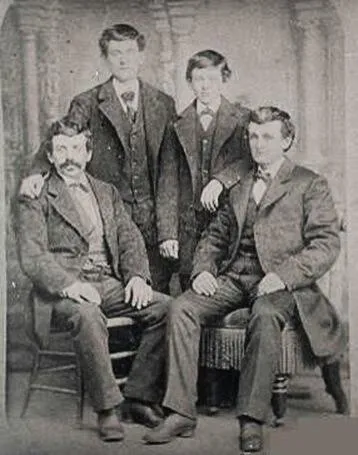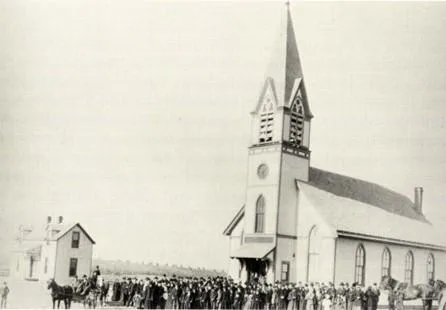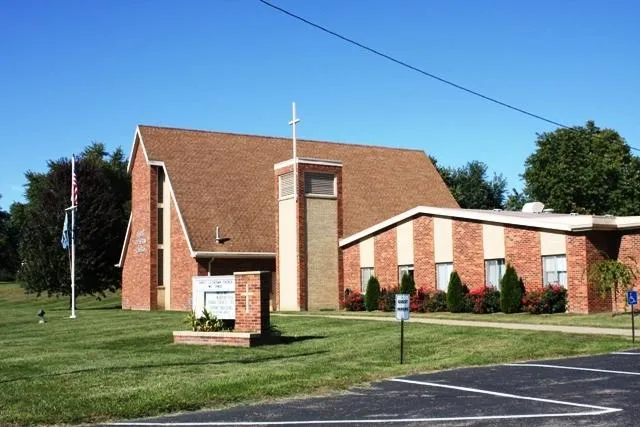A Brief History of Christ Evangelical Lutheran Church
Wathena, Kansas
Excerpts from "Not By Bread Alone: German Immigrant Churches in Doniphan County, Kansas as Archetypes in Preserving German Culture
A Thesis Presented to the Department of History, Humanities, Philosophy and Political Science of Northwest Missouri State University, 2008
by Brandon J. Benitz
The earliest origins of the Christ Lutheran Church date back to 1881 when several immigrant German Lutheran families in the Troy and Wathena area felt the need to again hear the Word of God and contacted Lutheran pastors in the Atchison, Kansas, and St. Joseph, Missouri, areas to come and minister to them in their living rooms. Like with anything new, this was no small feat for either the immigrants or the pastors to undertake. Lutherans in particular had a difficult time in acquiring a proper pastor as the number of German-speaking Lutheran pastors, like many other resources at the time, was in scarce supply.
For the next two years, Reverend W. Zschoche, who had earlier served as the first pastor at the Trinity Lutheran Church in Block, Kansas, rode out, or more often was picked up and then returned, once a month from his home in Atchison, to preach in various living rooms of the early members. Reverend Zschoche was certainly energetic to take on another congregation, as he was already the full-time pastor for the Trinity Lutheran Church in Atchison, nearly 20 miles away.
Five families are considered the charter members of the church, and it was in their living rooms that the church, originally known as the Evangelical Lutheran Church of Marion Township got its start. The patriarchs, or at least some descendants of each of those members’ families: Albert Benitz, W.F. Kiehnhoff, Frank Loroff, Ludwig Nimtz, and August Ruhnke were part of the Building Committee who later supervised the construction of the first church building and at least one descendent from each of those families is still represented on the church’s membership roll to this day.
Within a few years, believing that merely hearing the Word in their homes to be insufficient because they believed that Christian consciousness must also express itself by means of Christian congregation, the congregation decided to move away from the cycle of living room services and began holding their earliest formal services in the Cordonier School building.

Sons of Heinrich Benitz
shortly after emigrating from Germany
From left: William, Albert, Emil, and Fredrich Benitz
Courtesy of the Benitz Family Archives
Christ Lutheran saw a number of different pastors in its early years. In fact, reliable pastoral connections were often tenuous in the early years of the congregation. For example, Rev. Zschoche was only able to come out once a month and when he left Trinity, his replacement, Reverend C. Vetter, also came up from Atchison once a month. However, this arrangement did not last long, as the congregation there demanded that he terminate the arrangement to devote himself entirely to their congregation, which may have helped better serve Trinity but left Christ Lutheran without a pastor.
The situation with Christ Lutheran’s third pastor was even more fragile, as Reverend M. Grosse had to come from St. Joseph, as his regular position was as the head of St. Paul’s Lutheran Church. Given his tenuous travel schedule which included the fact that much of his thirty-mile journey was over rough country roads, coupled with his limited availability due to his duty to his full-time job, reliable and regular services were not always assured.
Christ Lutheran grew steadily throughout the 1880s. When it was formally dedicated on January 1, 1884, the original record showed 56 families, and 305 members, and an average of over 34 people took communion. In 1885, an average of over 21 people took communion, while in 1886, an average of over 23 people took communion.
From that year, which is when the Church’s official records were first kept, until December 30, 1890, Christ Lutheran’s continuous growth was meticulously documented. Sixty-six adults were baptized, sixty-five babies were born and subsequently baptized into the congregation, ten couples were married in the church, and eight more people were confirmed. By its 50th anniversary celebration, in 1934, the Christ Lutheran had baptized an accumulative total of 576 people, confirmed 360 others, married 111 couples, and conducted 115 funerals.

Christ Lutheran Church
Church building with Parsonage at left
Courtesy of Christ Lutheran Church Archives
Over the years, a number of factors motivated the congregation to find a better, more permanent, meeting place. A noteworthy growth in people, as well as the long-term stability of the congregation signaled the future strength of the church. A significant step towards that assurance was the establishment of its own Christian Day School in 1890. Given the early interest of the School and the relatively high attendance numbers, the congregation decided that the church needed to move from the Cordonier School building into a permanent church location of its own.
Thereafter, quality building ground was quickly identified for a suitable, permanent location. In 1894, the necessary acreage was acquired from local farmer Fred Snike and then A.J. Profe was awarded the construction bid at a cost of approximately $2,400. Thus, their first permanent building was erected on a county road about six miles southwest of Wathena and eight miles southeast of Troy, and it was the springboard they needed.
Within one year of its completion and dedication, they were able to call their first permanent pastor, the Reverend Martin Senne. Rev. Senne was a young pastor, fresh out of St. Louis’ Concordia Seminary, and coincidentally was the brother of Block’s Trinity Lutheran Church’s, Rev. H.C. Senne, who had come to that church in 1890. Rev. Martin Senne was installed at Christ Lutheran on August 10, 1895, and the congregation agreed to build him a 28’ by 28’ by 10’ personage on the grounds directly east of the church building, complete with a cistern for fresh water—all of which was paid off within a year.
Christ Lutheran’s “Christian Day School” initially opened in 1890 with fifty students in attendance and would grow larger over the next twenty-plus years. Although called the Christian Day School, by its members, the school was commonly referred to as the “Lutheran Day School” by others outside the church and is the common name remembered by nearly everyone today.
It was, like the Smith Creek “German School”, another of those aspects and extensions of the church that Christ Lutheran used to perpetuate their culture. Classes were held exclusively in German, taught by the pastor, supported by the congregation, and initially housed in the church building.
First opened in 1890, it was the primary schooling agent for the children of Christ Lutheran’s members for the next forty years and was very successful in its early years. As its growth continued, it was deemed necessary that the school be given its own building. Therefore, in 1908 a 26’ by 38’ addition was built onto the back (North) side of the church for an additional construction cost of $1,198.50
Eventually however, the perceived need and interest in the school diminished and the attendance numbers dropped accordingly. In 1928, with the pastor still teaching classes, enrollment numbered only twelve. With this decline in numbers, the rise of the local public school system, as well as the increasing desire to integrate their students into the local culture, the Lutheran Day School permanently closed in 1930. Though attempts were often made over the next several years to revive it, it never did re-open in its original form.
By 1896, a mere two years after the construction of their building, the church was able to draft and adopt Articles of Incorporation and in the summer of 1897 joined the Missouri Synod, where the current name of Christ [Evangelical] Lutheran Church was officially adopted. Two years after joining the Missouri Synod, Christ Lutheran established a cemetery on the grounds one-half mile west of the church building—a cemetery that remains active for members and their families to this day.
Christ Lutheran Church’s schooling and church services were held exclusively in German through the end of the nineteenth century and only began to infuse the occasional English-speaking services in the early twentieth century. In fact, it was 1901 before the first services were conducted in English, but even then, it was only one English service a month, as compared to the customary two services each Sunday in German. By 1915, at the behest of the outgoing pastor and with the blessing of the newly-installed young pastor, Christ Lutheran began holding it’s a second service in English every other Sunday and, for the first time, the Christmas services were conducted in both languages.
By the late 1920s, English had become more and more predominant in the worship services, to the point where the language being spoke in services were transposed. English became the primary language for both Sunday services with German-speaking services only being held once every other Sunday. Then, on March 2, 1941, Christ Lutheran held its last regular worship service in German. From then on, only a special-occasion service, or portion of a service, would retain any linguistic German connection.
Worship services were not the only areas of the church experiencing a shift in language use at the time. Until 1921, when the long-time church secretary stepped down, the minutes of all the congregational meetings had been recorded exclusively in German. With the installation of a new secretary came a change to recording the minutes only in English and by 1929, the church’s constitution had been translated into English.
Not all was well with the Christ Lutheran Church, however. Even though Missouri Synod pastors would have cringed at the thought of their actions being labeled as self-righteous, pious, or Calvinistic, early pastors throughout the synod, including Christ Lutheran’s, began following Loehe’s model and setting, expecting, and even codifying rigid standards for behavior.
Beginning in 1915, and continuing well into the 1930s, the church began a policy and practice of excommunicating members for such offenses as: lack of attendance, failure to support the church (either through monetary or physical means), involvement in illegal activities (sometimes only allegedly), refusal to settle grudges with fellow members, calling the pastor a false prophet, and breaking or failure to fulfill the vows of marriage.
Christ Lutheran was able to weather all manner of linguistic transitions and man-made storms, even if it found itself reeling after a God-made storm. On June 3, 1925, the steeple of the church, the congregation’s first permanent building, was struck by lightning during a thunderstorm. The ensuing fire completely destroyed the church and the adjoining Lutheran Day School. Undeterred by this setback, Christ Lutheran once again temporarily held services in the Cordonier School Building and was able to build a new structure on the same site and held services in the new building within a year.
Dedicated on April 18, 1926, the new building very closely resembled the original structure and would be the home of Christ Lutheran for the next forty-six years. Desiring to continue with the Lutheran Day School as well, classes were also held in the Cordonier School Building, and then held in the basement of the new church, once it was completed, though the school was discontinued in 1930.

Christ Lutheran's Second Building
with outcropping of Christian Day School building visible at left Courtesy of Christ Lutheran Church Archives

Christ Lutheran Church's Current Building
On May 18, 1969, just over four decades after dedicating their second church building, Christ Lutheran resolved to re-locate their congregation to a site that they felt was more advantageous to the growth and work of their church, thereby beginning the quest to find suitable land to meet that resolution. By March 1970, the congregation had decided to make Wathena part of its geographic location, and not just its title, by purchasing a plot of land on what was then the western edge of the town.
The current building was constructed at the prominent location of the corner of Highway 36 and Kirschbaum Avenue. It celebrated its first service on Easter Sunday, 1972. However, the congregation did not totally abandon the legacy of their former buildings. A number of the artifacts from their second building were removed and are currently hanging in the sanctuary or are on display in their entryway.
Years after establishing their new home, Christ Lutheran was able to bring back a significant part of its legacy. Driven by the same desire as their ancestors, to educate its next generation of church members, and despite having been closed for nearly eighty years, it was able to re-open its school, though in a different form.
In 1991, Christ Lutheran opened a pre-school housed within their current church building. Originally, conceived as a ministry for its members, it
too was purposely opened with the idea of perpetuating culture. Though not necessarily ethnic culture, per se, with German as the primary language, this pre-school initially served to inculcate the culture of the time, including the values, mores, and teachings of the church into the next generation of its members.
In the ensuing years however, the pre-school has grown beyond a service to the congregation and has opened to the community as a whole. In fact, today the Christ Lutheran Pre-School’s numbers are strong, and getting stronger. Not only because of the values it instills in its students but (realistically speaking) because it is the only licensed pre-school currently operating in Doniphan County.
Christ Lutheran Church, souls were nurtured and cultures were maintained for well over a century. And it was as much the religious, spiritual, and social fulfillment that parishioners sought and ultimately found, as their own cultural and ethnic fulfillment.
The families who started weekly Bible studies and worship services in their living rooms could have little imagined the impact their accomplishments would ultimately have on their demographic communities. Yet given the prevalence of numerous other churches throughout the Midwest, it is conceivable that they could have imagined that their actions would be similar to those of other German communities throughout the Midwest.

2108 Hwy 36, Wathena, Kansas
All Rights Reserved | © 2025 Christ Lutheran Church
Facebook
Youtube